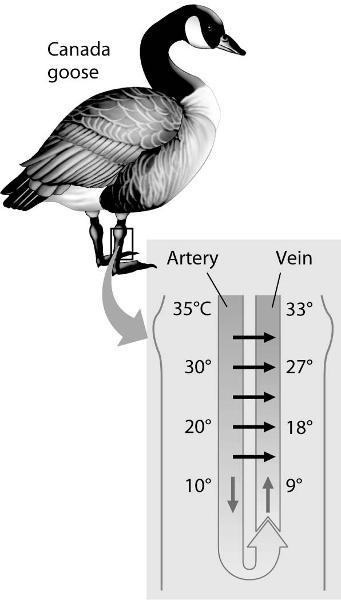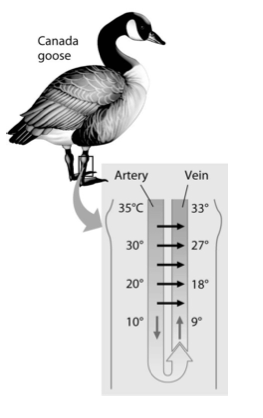Instructions for Side by Side Printing
- Print the notecards
- Fold each page in half along the solid vertical line
- Cut out the notecards by cutting along each horizontal dotted line
- Optional: Glue, tape or staple the ends of each notecard together
Campbell Biology Chapter 40 (powell_h)
front 1 1) When the temperature of the outside air exceeds their internal
body temperature, jackrabbits living in hot, arid lands will | back 1 Answer: B |
front 2 2) If thermoregulation is considered to be a secondary function of
the large ears of jackrabbits, then the primary function of the ears
is | back 2 Answer: C |
front 3 3) Which choice best describes a reasonable mechanism for animal
structures becoming better suited over evolutionary time to specific
functions? | back 3 Answer: C |
front 4 4) Penguins, seals, and tuna have body forms that permit rapid
swimming, because | back 4 Answer: D |
front 5 5) Evolutionary adaptations that help diverse animals directly
exchange matter between cells and the environment include | back 5 Answer: B |
front 6 6) The similar fusiform body shape of diverse animals, such as
sharks, penguins, and aquatic mammals, has evolved because | back 6 Answer: C |
front 7 7) The specialized structures of complex animals have evolved because
| back 7 Answer: D |
front 8 8) All animals, whether large or small, have | back 8 Answer: E |
front 9 9) As body size increases in animals, | back 9 Answer: A |
front 10 10) To increase the effectiveness of exchange surfaces lining the
lungs and the intestines, evolutionary pressures have | back 10 Answer: A |
front 11 11) The specialized function shared by the cells that line the lungs
and those that line the lumen of the gut is that both types of cells
| back 11 Answer: B |
front 12 12) Interstitial fluid is | back 12 Answer: D |
front 13 13) Multicellular organisms must keep their cells awash in an
"internal pond" because | back 13 Answer: B |
front 14 14) Tissues are composed of cells, and tissues functioning together
make up | back 14 Answer: A |
front 15 15) An exchange surface in direct contact with the external
environment is found in the | back 15 Answer: A |
front 16 16) Of the following choices, the epithelium with the shortest
diffusion distance is | back 16 Answer: A |
front 17 17) The absorptive epithelia in the gut are considered
"polarized" because | back 17 Answer: E |
front 18 18) Most of the exchange surfaces of multicellular animals are lined
with | back 18 Answer: D |
front 19 19) An example of a connective tissue is the | back 19 Answer: C |
front 20 20) Stratified cuboidal epithelium is composed of | back 20 Answer: A |
front 21 21) Coordinating body functions via chemical signals is accomplished
by | back 21 Answer: B |
front 22 22) Connective tissues typically have | back 22 Answer: D |
front 23 23) The fibers responsible for the elastic resistance properties of
tendons are | back 23 Answer: C |
front 24 24) If you gently twist your earlobe, it does not remain distorted
because it contains | back 24 Answer: B |
front 25 25) The nourishment, insulation, and support for neurons is the
result of activity by the | back 25 Answer: E |
front 26 26) Fibroblasts secrete | back 26 Answer: E |
front 27 27) Breathing is accomplished via the rhythmic contraction and
relaxation of | back 27 Answer: B |
front 28 28) Blood is best classified as connective tissue because | back 28 Answer: A |
front 29 29) Muscles are joined to bones by | back 29 Answer: B |
front 30 30) Most types of communication between cells utilize | back 30 Answer: C |
front 31 31) With its abundance of collagenous fibers, cartilage is an example
of | back 31 Answer: A |
front 32 32) A matrix of connective tissue is apparent in | back 32 Answer: A |
front 33 33) In a typical nerve cell, the nucleus is found in the | back 33 Answer: A |
front 34 34) All types of muscle tissue have | back 34 Answer: E |
front 35 35) All skeletal muscle fibers are both | back 35 Answer: C |
front 36 36) Cardiac muscle cells are both | back 36 Answer: A |
front 37 37) The type of muscle tissue surrounding internal organs, other than
the heart, is | back 37 Answer: E |
front 38 38) Food moves along the digestive tract as the result of
contractions by | back 38 Answer: B |
front 39 39) The cells lining the air sacs in the lungs make up a | back 39 Answer: B |
front 40 40) The body's automatic tendency to maintain a constant and optimal
internal environment is termed | back 40 Answer: C |
front 41 41) An example of a properly functioning homeostatic control system
is seen when | back 41 Answer: B |
front 42 42) An example of effectors' roles in homeostatic responses is
observable when | back 42 Answer: A |
front 43 43) Positive feedback has occurred when | back 43 Answer: C |
front 44 44) Positive feedback differs from negative feedback in that | back 44 Answer: B |
front 45 45) To prepare flight muscles for use on a cool morning, hawkmouth
moths | back 45 Answer: C |
front 46 46) In a survivably cold environment, an ectotherm is more likely to
survive an extended period of food deprivation than would an equally
sized endotherm because the ectotherm | back 46 Answer: C |
front 47 47) Humans can lose, but cannot gain, heat through the process of
| back 47 Answer: D |
front 48 48) An example of an ectothermic organism that has few or no
behavioral options when it comes to its ability to adjust its body
temperature is a | back 48 Answer: B |
front 49 49) An overheated and sick dog in a hot environment will have an
impaired thermoregulatory response when its | back 49 Answer: C |
front 50 50) Endothermy | back 50 Answer: B |
front 51 51) The panting responses that are observed in overheated birds and
mammals dissipates excess heat by | back 51 Answer: E |
front 52 52) An example of an organism that has only behavioral controls over
its body temperature is the | back 52 Answer: A |
front 53 53) Most land-dwelling invertebrates and all of the amphibians
| back 53 Answer: A |
front 54 54) The temperature-regulating center of vertebrate animals is
located in the | back 54 Answer: C |
front 55 55) A female Burmese python incubating her eggs can warm them using
| back 55 Answer: E |
front 56 56) In mammals this response is known as fever, but it is known to
raise body temperature in other bacterially infected animals,
including lizards, fishes, and cockroaches. | back 56 Answer: D |
front 57 57) Ingested foods inside the digestive tract of snakes are typically
digested by | back 57 Answer: B |
front 58 58) Seasonal changes in snake activity are due to the fact that the
snake | back 58 Answer: D |
front 59 59) Standard metabolic rate (SMR) and basal metabolic rate (BMR) are
| back 59 Answer: E |
front 60 60) For adult human females, the metabolic "costs" of
pregnancy and lactation are | back 60 Answer: C |
front 61 61) Among these choices, the least reliable indicator of an animal's
metabolic rate is the amount of | back 61 Answer: E |
front 62 62) During its months-long hibernation in its burrow, the body
temperature of a ground squirrel | back 62 Answer: C |
front 63 63) "Winter acclimatization" in cold-zone mammals can
include | back 63 Answer: C |
front 64 64) Hibernation and estivation during seasons of environmental stress
are both examples of | back 64 Answer: B |
front 65 65) Panting by an overheated dog achieves cooling by | back 65 Answer: C |
front 66 66) Catabolism of specialized brown fat depots in certain animals is
substantially increased during | back 66 Answer: D |
front 67 67) A moth preparing for flight on a cold morning warms its flight
muscles via | back 67 Answer: E |
front 68  68) The thin horizontal arrows in the figure above show that | back 68 Answer: C |
front 69  69) Examine the figure above. Near a goose's abdomen, the
countercurrent arrangement of the arterial and venous blood vessels
causes | back 69 Answer: A |
front 70 70) Imagine that you are a biologist who is attempting to get an
accurate measure of an animal's basal metabolic rate. The best time to
measure the metabolic rate is when the animal | back 70 Answer: A |
front 71 71) The body tissue that consists largely of material located outside
of cells is | back 71 Answer: B |
front 72 72) Which of the following would increase the rate of heat exchange
between an animal and its environment? | back 72 Answer: C |
front 73 73) Consider the energy budgets for a human, an elephant, a penguin,
a mouse, and a snake. The ________ would have the highest total annual
energy expenditure, and the ________ would have the highest energy
expenditure per unit mass. | back 73 Answer: A |
front 74 74) Compared with a smaller cell, a larger cell of the same shape has
| back 74 Answer: B |
front 75 75) An animal's inputs of energy and materials would exceed its
outputs | back 75 Answer: D |
front 76 76) You are studying a large tropical reptile that has a high and
relatively stable body temperature. How would you determine whether
this animal is an endotherm or an ectotherm? | back 76 Answer: C |
front 77 77) Which of the following animals uses the largest percentage of its
energy budget for homeostatic regulation? | back 77 Answer: E |